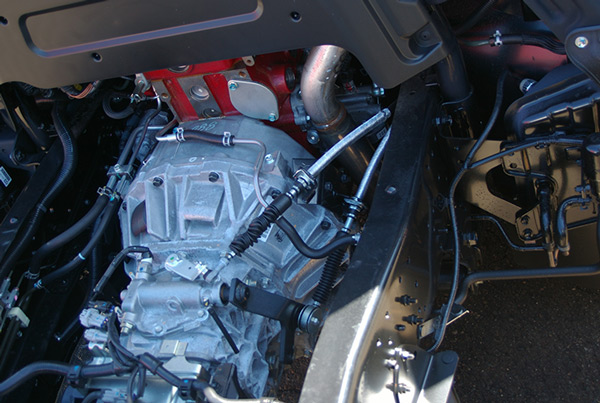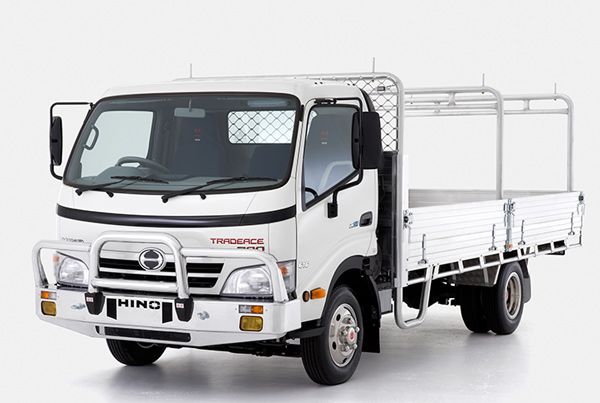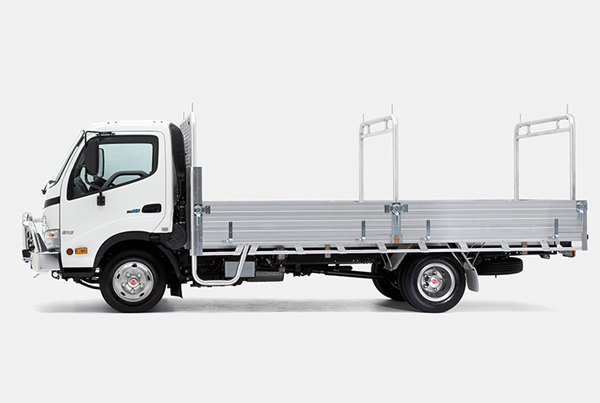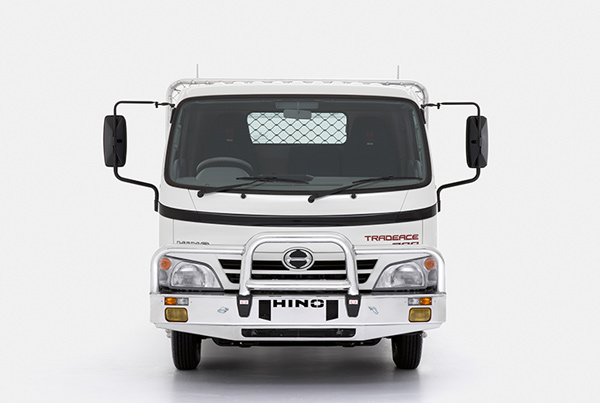Hino Trucks is tackling the opposition head-on with its revised 616 Trade Ace truck, aimed squarely at the trade and local government markets. Gary Worrall reports.
When it comes to competitive advantage in this market, one idea used to great effect by both Hino (and arch-rival Isuzu) is the ‘ready built’ truck. In short, a truck that can be driven off the lot and put straight to work, without needing a body builder to finish the vehicle.
In Hino’s case, these trucks are known as the ‘Ace’ range, and include the Trade Ace, Steel Ace and the latest version, the 614 Mini Ace.
Following the flooding in South East Queensland, Hino offered to send a truck to Brisbane for ATN to use to help with the flood clean up. The truck was a 616 Trade Ace, and it performed admirably.
The Trade Ace, which can be ordered in either full 6-tonne capacity or as a 4,495kg GVM to accommodate those with a car licence only, uses the proven 300 Series cab-chassis fitted with a purpose-built alloy drop side tray, ladder racks and an alloy mesh headboard to protect the rear window.
There is also an airbag-compatible alloy bullbar out front, sporting fog lamps, and extra park lamps and indicators. Inside, the seats gain a padded canvas cover and there are solid rubber floormats to catch the mud.
Otherwise, the Trade Ace body is identical to other 300 series models.
The tray is a generous 4.5m in length, which means plenty of room for long, trade-type loads such as timber, steel or piping.
Engine
The Trade Ace uses the 110kW (148hp) version of Hino’s proven N04C UH four-cylinder engine. The inter-cooled turbo-diesel is fitted with electronically-controlled common-rail direct injection for improved fuel economy and reduced emissions.
The engine produces a healthy 397Nm (293ft-lb) at 1,800rpm, with at least 340Nm available from 1,000rpm onward. Such twist available so low ensures driveability even with a heavy load from take-off, as well as the ability to ‘lug’ for in-gear acceleration.
Hino opted to continue with exhaust gas recycling (EGR) and added a diesel particulate active reduction system (DPR) to meet Euro 5 emission regulations.
Like most small cab-over trucks, the engine is packaged under the cockpit, however, there is plenty of noise and heat insulation between the powerplant and the people, so the cab will be comfortable on even the hottest days.
The engine cooling system also does an admirable job of dispersing the heat build-up, with the temperature gauge not shifting a millimetre after settling itself in the middle of the dial.
Transmission
Turning this motive force into motion is the M66YS six-speed manual transmission (a six-speed auto is also available).
Although it is a six-speed, in reality first is only for heavily-laden take-offs, with second more than adequate for regular driving.
Cab and Controls
The interior of the Trade Ace is equally well thought-out, with Hino’s cab designers adhering to ‘less is more’. There are as few buttons and switches as possible to ensure minimal confusion for the driver.
There’s no shortage of good things though, with a clear, easy-to-read dash in front of the driver offering large speedo and tacho, plus smaller gauges for water temperature and fuel level, along with warning lights for the usual suspects including high beam, low oil pressure, park brake, exhaust brake and more.
Among the more interesting lights is one for ‘Easy Start’, a function that keeps the brakes applied until the clutch is released, simplifying hill starts – especially when there is a heavy load in the tray – and eliminating the need for the park brake on take-off.
There are also warnings for airbag and ABS failures, and the all-important ‘water in the fuel filter’ warning, which can save expensive engine damage.
As with the other 300 Series models, there’s plenty of head, leg and shoulder room, regardless of the driver’s size, making the 616 a comfortable place to be while driving. Even three-up, with a pair of us 180cm-plus, didn’t induce claustrophobia.
The steering column is adjustable for both tilt and reach. Combine that with the sliding driver’s seat and it is almost impossible to be uncomfortable when driving.
Hanging off the steering column are stalks to control lights and indicators on the right, and wipers and the exhaust brake on the left.
The steering wheel is also home to the driver’s airbag, while the left-hand passenger is protected with an airbag nestling in the dash pad above the glovebox.
The third seat only gets a lap belt, rather than a full three-point seatbelt, but it folds down to double as a document tray and lunch table when there is nobody using it, providing a hard surface for doing the paperwork.
The seats are broad-based, providing plenty of support under the thigh, helping reduce driver fatigue, while the seat back wraps around the shoulders and hips to provide upper body support.
To the driver’s left are the controls for the air-conditioning and the audio system which includes an AM/FM/CD player, the two speakers of which offer reasonable sound quality.
Some of the buttons on the door, particularly on the radio, can be too close together when you are wearing gloves, or partially blocked by the steering wheel. Still, the dash layout is clear and simple, which is better than cluttered and confusing.
Performance
The Trade Ace body is a definite advantage in a variety of general load situations. Obviously, it’s not ideal if the usual load involves cartons, furniture or other goods that require protection from either the elements or light fingers, but if that’s the case, most operators would have ordered a pantech body in the first place.
In helping out with cleaning up parts of flood-devastated South East Queensland before putting the Trade Ace through its paces in a traditional road test the drop side tray was a real advantage.
While there are no photos of the Trade Ace on clean-up duty, rest assured it acquitted itself well, moving literally house-loads from flooded houses to the central dumping area at Fernvale in the Brisbane Valley.
Working with teams from RAAF Amberley and Sydney’s HMAS Waterhen naval depot, the Trade Ace was manoeuvrable enough to back down a driveway while sailors carried out the sodden plasterboard walls and ceilings of one house.
The long tray allowed virtually the entire house to be stripped, ready for rebuilding, as well as drawing comments that it carried more in its tray than one of the ADF’s own trucks that was working in the same area.
It was equally quick to unload at the dump area, with a squad of airmen scrambling on board after dropping the sides and pushing the damaged gyprock straight onto the mountain of possessions already cleared from other properties.
Although a heart-wrenching task, it was also good to know that thanks to the efforts of the mid-sized Hino, another family could begin the process of rebuilding that much sooner.
Having done our bit around Fernvale – to the point where it was declared ‘mission accomplished’ just a few days later – the opportunity came up to run the Trade Ace in a role more in keeping with what Hino intended: a tradie’s truck.
With a little help from the folks at Brisbane’s Redback Landscaping Supplies, the Trade Ace was loaded with some timber and hit the road to visit a nearby housing estate still under construction.
Despite being designed to operate in some rigorous environments, one of the first things you’ll notice is the relative lightness of the controls, as well as how accurate the feedback is from the truck.
Perhaps this is because, rather than despite, the fact it is intended to be driven by ‘non-truck drivers’ – after all, how many plumbers or landscapers would describe themselves as truck drivers even though the Trade Ace is their preferred mode of transport? The pedal pressures and steering inputs are most ‘untrucklike’.
The clutch, for example, is no heavier than that found in most small- to medium-sized cars, and offers plenty of feel when it comes to finding the balance point.
Even this is rendered redundant by the aforementioned ‘Easy Start’ system that holds the brakes on until the clutch is released, making hill starts almost stall-proof.
The accelerator and brake are similarly stress-free, with no more input required than what it takes to drive a Toyota Camry, although the feedback gives the driver plenty of warning before anything untoward happens at street level.
Despite some reasonably enthusiastic driving neither the ABS or EBD systems made an appearance during the test. The truck always felt secure and well tied-down, even when empty.
While the rear suspension could best be described as ‘choppy’ when the tray is empty, adding some weight soon settles the rear into the expected comfortable ride – no real surprise when you remember that the rear axle is rated to 4,400kg.
Like most light-duty trucks the Trade Ace is capable of holding 100km/h, but thanks to a 4.875:1 final drive it is happiest at a maximum speed of around 90km/h, and delights in working between 40 and 80km/h.
Importantly, the performance differential between laden and unladen is negligible at these speeds, however, the difference in ride quality is the significant factor.
Thanks to the team at Pacific Petroleum and the supply of diesel fuel for the road test component, fuel consumption worked out at 5.01 kilometres per litre, covering a mix of highway and urban driving, including a mix of road speeds from 50km/h to 100km/h.
The steering inputs are a fraction of the expected level, however, there is good communication back to the driver about where the wheels are pointing, and generally what is happening underneath the truck.
While the regular 300 Series cabs provide good levels of all-round vision, the Trade Ace improves it even more by virtue of the trayback configuration.
The driver can use the uncluttered front and side views, as well as the large door mirrors and also the large rear window.
Even with a large load in the tray, it is possible to look to the left and rear and get a good view of what is out there, so reversing and lane changing is easier and safer.
Verdict
There is plenty to recommend the 616 Trade Ace, including a spacious load area and good all-round vision as well as the usual 300 Series attributes, while the upgrade in emission control to Euro 5 has not hurt performance in the least.
Even better for potential buyers is the availability of the Trade Ace as part of the ‘Built to Go’ range, which means they are ready for delivery straight away and out earning their keep almost immediately.
Likes:
- Ready to work
- Good all-round vision
- Spacious cabin
- Comfortable seats
- Ease of operation
Dislikes:
- Minor switch gear can be fiddly
- Some buttons partially hidden by steering wheel
Specifications
Make/Model: Hino 616 Trade Ace
Configuration: Single cab 4×2, drop-side tray plus ladder racks
Engine: Hino N04C UH four-cylinder diesel, turbo-charged and inter-cooled, with electronically-controlled common-rail direct injection
Power/Torque: 110KW@2,700RPM / 397Nm@1,800rpm
Emission: Euro 5, using cooled EGR and diesel particulate active reduction system (DPR)
GVM/GCM: 5,500kg (optional 4,495kg) / 9,000kg (optional 7,995 kg)
Find Hino 616 trucks for sale.







